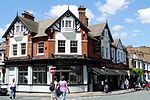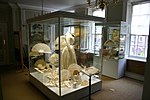Nelson's Ship in a Bottle
Collections of the National Maritime Museum, GreenwichPublic art in LondonTrafalgar Square

Nelson's Ship in a Bottle is a sculpture by the British-Nigerian artist Yinka Shonibare. Commissioned in 2009 by the Greater London Authority, it was originally placed on the Fourth Plinth in London's Trafalgar Square in 2010. It was subsequently relocated to a plinth outside the Sammy Ofer Wing of the National Maritime Museum in Greenwich, in southeast London, going on permanent display on 23 April 2012, two days before the museum's 75th anniversary. The work was purchased for £362,500 through a joint fund including a £50,000 contribution from the Art Fund and £264,300 from members of the public.
Excerpt from the Wikipedia article Nelson's Ship in a Bottle (License: CC BY-SA 3.0, Authors, Images).Nelson's Ship in a Bottle
The Avenue, London East Greenwich (Royal Borough of Greenwich)
Geographical coordinates (GPS) Address External links Nearby Places Show on map
Geographical coordinates (GPS)
| Latitude | Longitude |
|---|---|
| N 51.4803 ° | E -0.00531 ° |
Address
Nelson's Ship in a Bottle
The Avenue
SE10 8XJ London, East Greenwich (Royal Borough of Greenwich)
England, United Kingdom
Open on Google Maps









